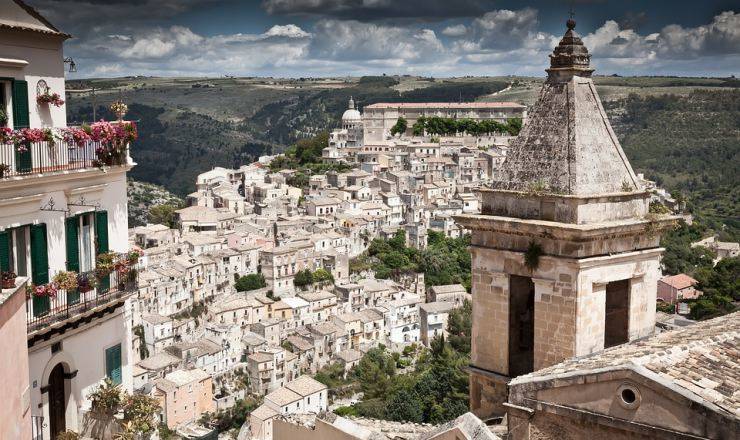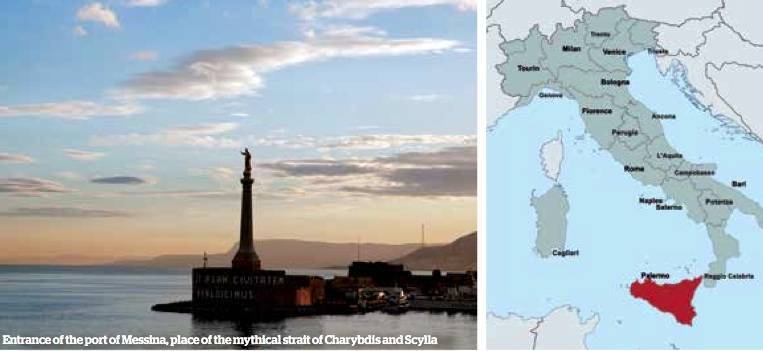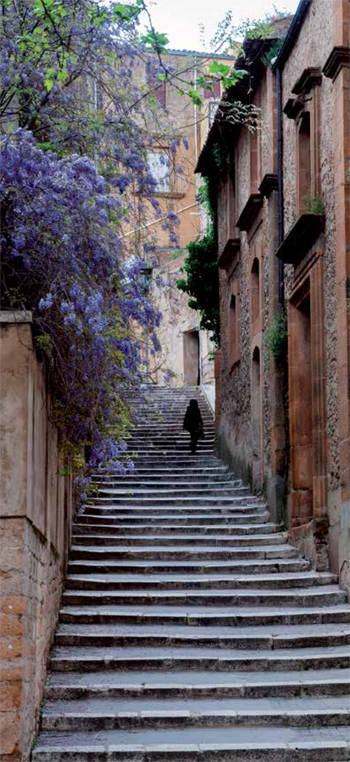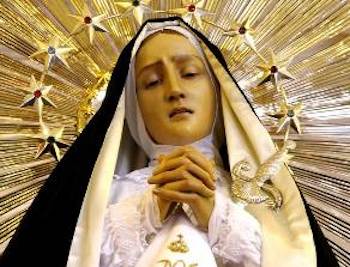Baroque Sicily. When History and Art Join Forces — and Win
Four baroque corners in Palermo
Known throughout the world for its rowdy vitality, Palermo is also renowned for its marvelous baroque architecture. It’s the perfect place to start our trip, focusing on four corners all of which will surely take your breath away. The first sports marmi mischi (colored or inlaid marble): a sumptuous local specialty that bears witness to the wealth and politics of a few eighteenth- century polychrome churches that never cease to amaze.
One of the most beautiful is the Chiesa del Gesù, set in the heart of a working class neighborhood and laden with marble inlays of every color, numerous putti, scantily clad figures, angels, peacocks, winged dogs and griffins clinging to pillars in an lively blend of realism and fantasy.
Behind the altar, in the recesses of the choir, the sculptor Vitagliano recreated scenes from the Old Testament taken from the story of David. The statues are set against a backdrop of yellow and blue inlay and depict three workaday commoners – a miller, a vintner and a man delivering bread – who stand in sharp contrast to the church’s theatrical pomp, naturalist motifs in a lyrical setting. Palazzo Gangi, our second baroque corner, was made famous by Visconti in his movie Il Gattopardo (The Leopard).
A remnant of Palermo’s old aristocracy, Palazzo Gangi is the only family house of its kind in such good condition, thanks to the ingenious work of the current owner, a woman from Lyons who married Prince Gangi. The princess offers private tours of the adjoining halls she has restored bit by bit, wall hanging by wall hanging, trinket by trinket – repairing, gluing, scrubbing and polishing with admirable earnestness and self-sacrifice.
Rare cabinets, chandeliers teeming with branches, armchairs with gnarled feet and intricate lace adorn every room without a care for how much it once cost – or will cost in the future. The ballroom and adjoining hall of mirrors are among the most beautiful antique remnants of a class that has all but disappeared. What impeccable taste! What unpretentious beauty!
On the third corner we find the three oratories decorated by Giacomo Serpotta, a stucco worker about whom little is known. In fact, his talents never made it off the island. Besides his work on the Santo Spirito Monastery in Agrigento, Serpotta exclusively operated in Palermo, where he was born in 1656 and died in 1732. His body, buried in the basement of the Chiesa di San Matteo, disappeared when the cemetery was removed. Until recently, there had been no mention of his work. For two and a half centuries, he was forgotten, confirming how little Sicilians care to boast of their reputation.
Or should their silence be attributed to indifference? Contempt? Distaste for attention? Sicilians, you might say, prefer to stay in the shadows, where their talents may remain intact, intangible, sacred, like a diamond in the depths of a mine. Indeed inside Serpotta’s three oratories you will discover the work of a sculptor of striking imagination and skill, whose medium was not marble or bronze but stucco.
The artist’s specialty was a snake or lizard (serpiotta) that he would sometimes carve into the corner of his statues. Serpotta’s world is entirely white, and you’re not immediately aware of it, given that the first oratory he worked on, the Rosario in San Domenico, houses massive paintings by van Dyck, Pietro Novelli and other famous artists, which are embedded in the walls and above the altar.
In the next chapel Serpotta decorated, Santa Zita, a flurry of white shapes fills the space. You see nothing but white – life-size female Virtues and playful putti frolicking about like acrobats, skipping, swaying, playing with their mouths and genitals, among garlands of roses, bunches of fruit, and war trophies. But this child-like space can’t muffle the noise of war: the Battle of Lepanto is rendered in admirable detail in a large panel above the entrance and between two older boys—one, holding his head high and staring insolently, symbolizes the victor; the other, in a turban, the defeated Turks. The twelve alcoves along the walls reveal the mysteries of the Rosary.
These miniature theaters were fashioned with exquisite precision and poetry. Serpotta may have never set foot off the island, but his deep understanding of perspective makes you wonder if his bas- reliefs were borrowed from Donatello. Shapes gradually recede, creating a sense of depth. The last oratory is in San Lorenzo, adjacent to the church of San Francesco d’Assisi, and introduces a new kind of human next to the serious Virtues and whimsical babies, several naked adolescents stretched out or prone in poses redolent of Michelangelo’s Ignudi or those by Carracci in the Palazzo Farnese in Rome.
The total absence of adult men among dozens of figures is novel and mysterious; it’s a world of white with only women and children. When Serpotta was fourteen years old, his father was sent to the galleys and died a slave. Does the color white, combined with the absence of virile characters, suggest a boy who has erased his father from his mind? Or is it a post-mortem homage to the idealized criminal according to the Sicilian code of omertà?
Our fourth and last corner lies at the opposite of this relatively sober style. It is represented by the over-the-top baroque of Bagheria, a small town about ten miles from Palermo. Here, the Prince of Palagonia topped the wall surrounding his villa with extravagant “monsters” that would startle Goethe, one of the first visitors to see them. Dwarfs riding lions, hunchbacks donning large wigs, dragons with donkey ears, bird-women, fish-men, and oversized heads on contorted bodies. If you attribute them to the wild imaginings of the mentally insane, then you fail to grasp the Mediterranean mindset.
Like a Pirandello character, the “mad” prince was fully aware of what he was doing. Humor and ridicule were to blame, not mental illness. Indeed, chances are he commissioned these statues to tarnish the image of a Sicily forever bound by the cult of restraint and reason. Bagheria’s brand of baroque is merely an exaggeration of a quintessential island trait: a tendency to defy Greek clichés and impatiently dispel a myth that had reduced the island to a subject of academic investigation.
On the contrary, what has best represented Sicily since the end of antiquity are not the columns you see on the temples, the tiered seats in the theaters or the grandeur of the ruins, but rather art that express a lust for life, the direct result of a tragic and turbulent history and the constant threat of violence from the earth and below the earth – the island’s erratic earthquakes and volcanic eruptions. “Sicilitude” is a permanent state of anxiety. Mount Etna beckons.
Lava, basalt, blackened prisms, black lava flows, heaps of carbonized ash, clouds of black smoke, random craters formed by ice melt: the world as it was, a telluric jumble. It’s not uncommon to emerge from the slag heaps and see a shrub suddenly burst into flames, reclaimed by the fire underneath the surface. How can you maintain your composure or your bourgeois lifestyle when you can’t even trust the earth your house stands on? It’s as if the notion of saving for the future, planning ahead, meeting obligations and building a career did not exist in Sicily. What’s the point when at any minute it could all go up in smoke?
Catania
The provinces of Catania, Ragusa and Syracuse were devastated by the 1693 earthquake. Catania was almost entirely rebuilt out of Etna’s lava and rock, which explains the city’s strange black hue. A rational urban plan was drawn up. Streets were designed to intersect at right angles (or almost) and, unlike the labyrinth that is Palermo, hold very few surprises. The austere monuments are baroque, which was the style of the day.
Around 1730, the city’s authorities called on the architect Giovanni Battista Vaccarini, a native of Catania who trained in Rome. He brought the noble and grand Roman style to Sicily and extinguished any local imagination. His greatest works are the city hall and the facade of the cathedral in Catania’s Piazza del Duomo. There is something about them that is regular and cold, a curious blend of puritanism and the baroque, further underscored by the juxtaposition of white stone and black lava.
Catania is home to less officious but infinitely more delightful places and monuments. Near the port, the facade of Palazzo Biscari is laden with herms, putti and copious floral decorations. Inside the palace, the ballroom, which has an uneven, arched ceiling decorated with stucco and painted with extravagant volutes, is punctuated by an oval opening that draws the eye to a cupola with an allegoric fresco.
The Via dei Crociferi is “short but infinitely beautiful,” according to writer Vitaliano Brancati. Covered in gates and chains, San Giuliano, San Francesco Borgia, San Benedetto and the other churches lining this street evoke a past where devotion, intrigue and gluttony (the pastries and ice cream in Catania are divine!) come together powerfully and harmoniously.
There are also sumptuous railings on the balcony overhanging the splendid doorway on the facade of Palazzo Valle. The railings were enlarged to accommodate women’s panniered dresses (fashion in Sicily was still dictated by Spanish pomp and circumstance). Too opulent and exuberant for Rome, the curves and counter- curves of the palace’s gallery make it one of the most beautiful balconies in all of Sicily. Lastly, the gigantic proportions and abundance of diamond shaped bossages, caryatids, putti and floral patterns swallowing up the windows and balconies of the monastery and church of San Nicolò are as ostentatious as any monastery in Mexico.
Southeast Sicily
The southeastern towns of Noto, Modica, Ragusa, and Scicli were also destroyed in 1693. Noto, razed to the ground, was reconstructed at a new site several miles away, marking the beginning of the area’s reconstruction. Since baroque was the fashion of the day – though no one knew it as such – the area was rebuilt in the baroque style. As a result, the group of towns that were rebuilt exemplifies what we now refer to as Sicilian baroque, which is quite different from Roman or even Palermitan baroque.
A less sumptuous, more country, more earthy baroque. No marble or gold but a soft, golden-colored stone ingeniously dispensed. The architect Rosario Gagliardi (like Serpotta, an unknown) used the slope of the land to form the facades of the Chiesa di San Giorgio in Modica, the Chiesa di San Giorgio in Ragusa, and open- air theaters that used the sun as a spotlight. Noto, or Netum, was built from the ground up. It is the most successfully reconstructed city and the most spectacular surprise in all of Sicily. Built into the side of a hill, the city boasts a main street flanked by honey-hued limestone religious buildings all facing the same direction.
The first is the conventional Chiesa di San Francesco, which sits atop an immense staircase with three landings. Then there is the cathedral, whose staircase is equally monumental. A bit farther along, Rosario Gagliardi’s Chiesa di San Domenico has a convex facade with two orders and columns. The portal has a broken pediment and a semi- circular crown between two broken half-pediments. The street runs east to west and, in the late afternoon, the sun illuminates the gold limestone and accentuates the churches’ angles, creating a lyrical, solar parade unlike anything else you’ll see in Europe.
It is, however, pointless to go inside these churches. Contrary to what you’d find in Palermo, their interiors are bare, cold, unexciting. They are all about the profane pleasure of the spectacle, not somber devotion. The decor created by the curves and counter curves, ceremonious staircases, added archways, pilasters and capitals of these facades would seem extravagant if it were not for the soft and sensual color of the stone. As for Noto’s Villadorata princes, their only claim to fame is the over ornate anthropomorphic and zoomorphic corbels found under the six balconies of their palace.
Syracuse
Finally we arrive in Syracuse. Surrounded by water, Ortygia – the former heart of the city, a white oasis in the sea, a kind of lagoon – is the most beautiful city in Sicily. The island’s history can be read in the cathedral. In the beginning, it was a Greek temple dedicated to the goddess Athena. When it was transformed into a Christian basilica, the powerful Doric columns were integrated into the new structure and are still visible from both inside and out. In 1728, a superb baroque facade was added by Palermo architect Andrea Palma.
A facade with two orders is joined by opulent volutes and adorned with columns and statues ingeniously detached from the wall, which create a sense of depth. The miracle is how these three styles are reunited so vibrantly and harmoniously. In front of this impressive aggregate building is a white piazza paved in white flagstones and flanked by white palaces and coffee shops where you can order white almond milk, the nectar of the gods. (The best almond milk is served at Minerva, a bar to the left of the cathedral.) At the back of the piazza, in the small ultra baroque church of Santa Lucia, with its pot-bellied iron balconies, hangs the Burial of Saint Lucy, Caravaggio’s famous work painted in Syracuse. The two giant gravediggers in the foreground create a perfectly baroque disproportion in this powerful, tragic scene.











































Comments
THE HELP YOU NEED IN YOUR RELATIONSHIP